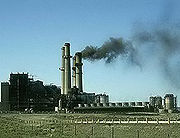Cancer
Cancer is a group of diseases in which cells are
aggressive (grow and divide without respect to normal limits), invasive
(invade and destroy adjacent tissues), and/or metastatic (spread to
other locations in the body).
These three malignant properties of cancers differentiate them
from benign tumors, which are self-limited in their growth and do not
invade or metastasize (although some benign tumor types are capable of
becoming malignant).
Cancer may affect people at all ages, even fetuses, but risk for the more common varieties tends to increase with age.
Cancer causes about 13% of all deaths.
Apart from people, forms of cancer may affect animals and plants.
Nearly all cancers are caused by abnormalities in the genetic material of the transformed cells.
These abnormalities may be due to the effects of carcinogens, such as tobacco smoke, radiation, chemicals, or infectious agents.
Other cancer-promoting genetic abnormalities may be randomly acquired
through errors in DNA replication, or are inherited, and thus present
in all cells from birth.
Complex interactions between carcinogens and the host genome may
explain why only some develop cancer after exposure to a known
carcinogen.
New aspects of the genetics of cancer pathogenesis, such as DNA
methylation, and microRNAs are increasingly being recognized as
important.
Genetic abnormalities found in cancer typically affect two general
classes of genes.
Cancer-promoting oncogenes are often activated in cancer cells,
giving those cells new properties, such as hyperactive growth and
division, protection against programmed cell death, loss of respect for
normal tissue boundaries, and the ability to become established in
diverse tissue environments.
Tumor suppressor genes are often inactivated in cancer cells,
resulting in the loss of normal functions in those cells, such as
accurate DNA replication, control over the cell cycle, orientation and
adhesion within tissues, and interaction with protective cells of the
immune system.
Cancer is usually classified according to the tissue from which the
cancerous cells originate, as well as the normal cell type they most
resemble.
These are location and histology, respectively.
A definitive diagnosis usually requires the histologic examination of
a tissue biopsy specimen by a pathologist, although the initial
indication of malignancy can be symptoms or radiographic imaging
abnormalities.
Most cancers can be treated and some cured, depending on the specific type, location, and stage.
Once diagnosed, cancer is usually treated with a combination of surgery, chemotherapy and radiotherapy.
As research develops, treatments are becoming more specific for different varieties of cancer.
There has been significant progress in the development of targeted
therapy drugs that act specifically on detectable molecular
abnormalities in certain tumors, and which minimize damage to normal
cells.
The prognosis of cancer patients is most influenced by the type of cancer, as well as the stage, or extent of the disease.
In addition, histologic grading and the presence of specific
molecular markers can also be useful in establishing prognosis, as well
as in determining individual treatments.
For more information about the topic Cancer, read the full article at Wikipedia.org, or see the following related articles:
 Metastasis
— Metastasis is the spread of cancer from its primary site to other
places in the body (e.g., brain, liver). Cancer cells can break away
from a primary ... > read more
Metastasis
— Metastasis is the spread of cancer from its primary site to other
places in the body (e.g., brain, liver). Cancer cells can break away
from a primary ... > read more
Tumor suppressor gene
— A tumor suppressor gene is a gene that reduces the probability that a
cell in a multicellular organism will turn into a tumor cell. A
mutation or ... > read more
Tumor
— Tumor (American English) or tumour (British English) originally means
"swelling", and is sometimes still used with that meaning. Tumor
meaning ... > read more
Carcinogen
— In pathology, a carcinogen is any substance or agent that promotes
cancer. Carcinogens are also often, but not necessarily, mutagens or ...
> read more








